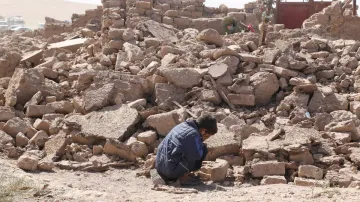New Delhi: An earthquake of a magnitude of 5.7 on the Richter scale hit Afghanistan on Friday, according to the National Center for Seismology. There have been no reports of earthquake-related casualties or damage as of now. In a post on X, the National Center for Seismology said, "EQ of M: 5.7, On 29/08/2024 11:26:38 IST, Lat: 36.51 N, Long: 71.12 E, Depth: 255 Km, Location: Afghanistan."
Besides Afghanistan, a 5.4-magnitude earthquake shook the Pakistani capital of Islamabad and several other areas in the northwestern Khyber Pakhtunkhwa and eastern Punjab provinces, the Pakistan Meteorological Department (PMD) said, with no loss reported in its wake. The earthquake struck at a depth of 215 kilometres with its epicentre located in the Hindu Kush region of neighbouring Afghanistan, according to the PMD.
Earlier on August 16, an earthquake of a magnitude of 4.8 on the Richter scale hit Afghanistan on Friday, according to the National Center for Seismology. According to NCS, the tremors were felt at 6:35 pm (IST). The epicentre of the earthquake was located at latitude 37.09 North and longitude 71.17 East and at a depth of 130 kilometres.
In a post on X, National Center for Seismology said, "EQ of M: 4.8, On: 16/08/2024 06:35:16 IST, Lat: 37.09 N, Long: 71.17 E, Depth: 130 Km, Location: Afghanistan."
Earlier in 2023, a powerful magnitude-6.3 earthquake followed by strong aftershocks killed over 2,000 people, and left 9,000 injured in western Afghanistan. Afghanistan is especially vulnerable to earthquakes as the entire country is located on two major active faults that have the potential to rupture and cause extensive damage.
Most homes in Afghanistan lack a good foundation and are often poorly constructed, according to a 2021 paper published in the Journal of Disaster Risk Studies. Structures are either made of burnt bricks with cement mortar or are sun-dried brick masonry buildings with load-bearing walls.
The thickness of the walls ranges from 20 to 30 cm for the burnt bricks and about 40 cm to 80 cm for the sun-dried brick structures. These homes can be covered by large and often heavy roofs that can cave into the structure, making them extremely vulnerable to seismic activity, according to the report.
(With inputs from agencies)
ALSO READ: Taliban codify strict morality laws: Women ordered to cover faces, men required to grow beards
Latest World News
